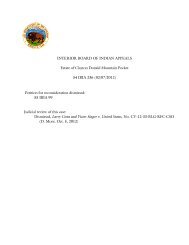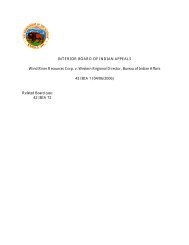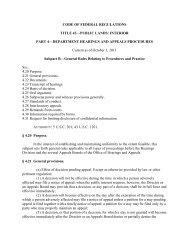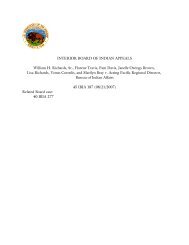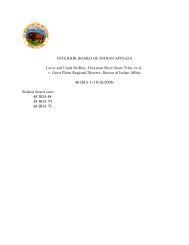175IBLA029 - About the Office of Hearings and Appeals - US ...
175IBLA029 - About the Office of Hearings and Appeals - US ...
175IBLA029 - About the Office of Hearings and Appeals - US ...
Create successful ePaper yourself
Turn your PDF publications into a flip-book with our unique Google optimized e-Paper software.
EVANS-BARTON, LTD<br />
175 IBLA 29 Decided June 26, 2008
United States Department <strong>of</strong> <strong>the</strong> Interior<br />
<strong>Office</strong> <strong>of</strong> <strong>Hearings</strong> <strong>and</strong> <strong>Appeals</strong><br />
Interior Board <strong>of</strong> L<strong>and</strong> <strong>Appeals</strong><br />
801 N. Quincy St., Suite 300<br />
Arlington, VA 22203<br />
EVANS-BARTON, LTD<br />
IBLA 2008-17 Decided June 26, 2008<br />
Appeal from a Decision Record <strong>and</strong> Finding <strong>of</strong> No Significant Impact<br />
issued by <strong>the</strong> Winnemucca, Nevada, Field <strong>Office</strong>, Bureau <strong>of</strong> L<strong>and</strong> Management,<br />
approving <strong>the</strong> issuance <strong>of</strong> a geo<strong>the</strong>rmal lease subject to site-specific stipulations.<br />
NV-020-07-EA-19.<br />
Affirmed.<br />
1. Environmental Quality: Environmental Statements--<br />
Geo<strong>the</strong>rmal Leases: Environmental Protection: Generally--<br />
Geo<strong>the</strong>rmal Leases: Leases <strong>and</strong> Permits: Generally--<br />
Geo<strong>the</strong>rmal Leases: Stipulations--National Environmental<br />
Policy Act <strong>of</strong> 1969: Environmental Statements<br />
The Bureau <strong>of</strong> L<strong>and</strong> Management has authority to require<br />
<strong>the</strong> execution <strong>of</strong> special stipulations to protect<br />
environmental <strong>and</strong> o<strong>the</strong>r l<strong>and</strong> use values for l<strong>and</strong>s where<br />
those values are present. A decision imposing a 1/2-mile<br />
NSO stipulation for <strong>the</strong> protection <strong>of</strong> a site <strong>of</strong> religious<br />
<strong>and</strong> cultural importance to Native American Tribes will be<br />
upheld when <strong>the</strong> record shows it to be <strong>the</strong> result <strong>of</strong> a<br />
reasoned analysis <strong>of</strong> all pertinent factors with due regard<br />
for <strong>the</strong> public interest <strong>and</strong> reflects a reasonable means to<br />
accomplish a proper Departmental purpose.<br />
APPEARANCES: David M. Evans, Managing Member, Evans-Barton, LTD, Reno,<br />
Nevada; Nancy S. Zahedi, Esq., <strong>Office</strong> <strong>of</strong> <strong>the</strong> Regional Solicitor, U.S. Department <strong>of</strong><br />
<strong>the</strong> Interior, Sacramento, California, for <strong>the</strong> Bureau <strong>of</strong> L<strong>and</strong> Management.<br />
OPINION BY ADMINISTRATIVE JUDGE ROBERTS<br />
Evans-Barton, LTD (Evans-Barton), has appealed from <strong>the</strong> September 14,<br />
2007, Decision Record (DR) <strong>and</strong> Finding <strong>of</strong> No Significant Impact (FONSI) issued by<br />
<strong>the</strong> Winnemucca, Nevada, Field <strong>Office</strong>, Bureau <strong>of</strong> L<strong>and</strong> Management (BLM), based<br />
175 IBLA 29
IBLA 2008-17<br />
upon environmental assessment (EA) NV-020-07-EA-19, approving issuance <strong>of</strong> a<br />
geo<strong>the</strong>rmal lease, with site-specific stipulations, for l<strong>and</strong>s in <strong>the</strong> Kyle Hot Springs area<br />
in Mt. Diablo Meridian, Pershing County, Nevada. Evans-Barton seeks relief from <strong>the</strong><br />
stipulation providing for no surface occupancy (NSO) within ½ mile <strong>of</strong> Kyle Hot<br />
Springs. As explained below, we affirm BLM’s decision to impose that stipulation.<br />
I. BACKGROUND<br />
Kyle Hot Springs is located near <strong>the</strong> center <strong>of</strong> a 160-acre tract <strong>of</strong> privately<br />
owned property situated in secs. 1 <strong>and</strong> 12, T. 29 N., R. 36 E., Mt. Diablo Meridian.<br />
The surrounding l<strong>and</strong>s in secs. 1 <strong>and</strong> 12, as well as adjacent secs. 2 <strong>and</strong> 11, are public<br />
l<strong>and</strong>s. On August 10, 2000, Evans-Barton filed application NV-76438 for a<br />
noncompetitive geo<strong>the</strong>rmal lease to encompass approximately 2,400 acres <strong>of</strong> public<br />
l<strong>and</strong>s in secs. 1, 2, 11, <strong>and</strong> 12. The public l<strong>and</strong>s involved are managed by BLM under<br />
<strong>the</strong> Sonoma-Gerlach Management Framework Plan (MFP). This MFP provides that<br />
l<strong>and</strong>s within <strong>the</strong> Sonoma-Gerlach Resource Area are open to geo<strong>the</strong>rmal <strong>and</strong> oil <strong>and</strong><br />
gas leasing with specified restrictions, including an NSO stipulation for “S-1 cultural<br />
<strong>and</strong> historical sites.” Sonoma-Gerlach MFP, Sec. III, Minerals 5.5.<br />
On September 10, 2002, BLM issued a DR/FONSI as a result <strong>of</strong> a<br />
programmatic EA to consider <strong>the</strong> leasing <strong>of</strong> geo<strong>the</strong>rmal resources within <strong>the</strong> Sonoma-<br />
Gerlach <strong>and</strong> Paradise-Denio Resource Areas <strong>and</strong> to update geo<strong>the</strong>rmal lease<br />
stipulations. In that decision, <strong>the</strong> Field Manager deferred geo<strong>the</strong>rmal leasing <strong>of</strong><br />
several areas having high potential for significant impacts until more extensive, sitespecific<br />
environmental analysis could be completed. DR/FONSI at 2. One area<br />
deferred was <strong>the</strong> Kyle Hot Springs l<strong>and</strong>s due to “Native American Religious<br />
concerns.” Id. BLM also decided to update <strong>the</strong> st<strong>and</strong>ardized Geo<strong>the</strong>rmal Lease<br />
Stipulations as a result <strong>of</strong> its programmatic EA. A copy <strong>of</strong> that update was attached<br />
to <strong>the</strong> DR/FONSI, which provided in pertinent part: “For development <strong>and</strong><br />
production phases, surface occupancy may be limited to a specific distance or<br />
precluded at hot springs, pending conclusion <strong>of</strong> <strong>the</strong> native consultation process.”<br />
Attachment to DR/FONSI at 6. The lease at issue, NV-73698, was among those<br />
identified as a pending lease for which <strong>the</strong> NSO stipulation would be evaluated. Id.<br />
Also included was a general cautionary provision that “[a]ll development activities<br />
proposed . . . are subject to <strong>the</strong> requirement for Native American consultation prior to<br />
BLM authorizing <strong>the</strong> activity, [which] may extend time frames for processing . . . , as<br />
well as, changes in <strong>the</strong> ways in which developments are implemented.” Id.<br />
BLM initiated site-specific analysis in May 2006 <strong>and</strong> sought public comment to<br />
help identify potential environmental <strong>and</strong> socioeconomic impacts <strong>and</strong> issues during a<br />
scoping period held August 21 through September 22, 2006. By letters sent<br />
September 28, 2006, BLM apprised <strong>the</strong> following Native American Tribes <strong>of</strong> <strong>the</strong> ongoing<br />
environmental analysis: Lovelock Paiute Tribe, Winnemucca Paiute Shoshone<br />
175 IBLA 30
IBLA 2008-17<br />
Tribe, Fallon Paiute Shoshone Tribe, Pyramid Lake Paiute Tribe, <strong>and</strong> Battle Mountain<br />
B<strong>and</strong> <strong>of</strong> <strong>the</strong> Te-Moak B<strong>and</strong> <strong>of</strong> <strong>the</strong> Western Shoshones. EA at 8.<br />
In <strong>the</strong> ensuing EA, BLM described <strong>the</strong> Native American relationship with Kyle<br />
Hot Springs as follows:<br />
Kyle Hot Springs has been used from ethnographic times<br />
through recent times by <strong>the</strong> Lovelock Paiute for medicinal <strong>and</strong> spiritual<br />
purposes. Past consultation efforts <strong>and</strong> ethnographies document <strong>the</strong><br />
importance <strong>of</strong> hot springs to <strong>the</strong> Native American tribes in this area.<br />
Hot springs have long been an integral part <strong>of</strong> Native American<br />
medicinal, social, <strong>and</strong> spiritual activities within nor<strong>the</strong>rn Nevada.<br />
Kyle Hot Springs has been identified as a Traditional Cultural Property<br />
(TCP) by <strong>the</strong> Lovelock Paiute because <strong>of</strong> <strong>the</strong> healing <strong>and</strong> spiritual<br />
qualities <strong>of</strong> <strong>the</strong> springs <strong>and</strong> <strong>the</strong> associated mud. The Lovelock Tribe<br />
<strong>and</strong> <strong>the</strong> Battle Mountain B<strong>and</strong> <strong>of</strong> <strong>the</strong> Te-Moke B<strong>and</strong> <strong>of</strong> <strong>the</strong> Western<br />
Shoshones have previously expressed concerns regarding geo<strong>the</strong>rmal<br />
leases <strong>and</strong> activities in <strong>the</strong> vicinity <strong>of</strong> <strong>the</strong> hot springs, <strong>and</strong> Kyle Hot<br />
Springs in particular.<br />
EA at 8-9, sec. 3.1.5 (Native American Religious Concerns). BLM <strong>the</strong>n discussed<br />
establishing lease stipulations based upon its consultation with <strong>the</strong> Native American<br />
Tribes:<br />
In <strong>the</strong>ir response to <strong>the</strong> consultation letter for this lease, <strong>the</strong> Fallon<br />
Tribe also expressed concerns about impacts to <strong>the</strong> hot springs, <strong>and</strong> <strong>the</strong><br />
fragile ecosystems surrounding <strong>the</strong>m, from drilling <strong>and</strong> o<strong>the</strong>r<br />
geo<strong>the</strong>rmal activities. In past consultations, <strong>the</strong> Lovelock Tribe has<br />
recommended a 1 mile “protection zone” around Kyle Hot Springs. The<br />
Battle Mountain B<strong>and</strong>, <strong>the</strong> Fallon Paiute Shoshone Tribe, <strong>and</strong> <strong>the</strong><br />
Pyramid Lake Tribe have all stated that <strong>the</strong>y support <strong>the</strong> Lovelock<br />
Tribe’s position. The Lovelock Tribe has also expressed concerns about<br />
access to hot springs <strong>and</strong> o<strong>the</strong>r traditional areas in <strong>the</strong> past.<br />
Id. Noting that <strong>the</strong> springs are located on private l<strong>and</strong>, BLM outlined its authority to<br />
impose protective restrictions on leasing by observing that “Executive Order 13007,<br />
‘Indian Sacred Sites’ also applies to Kyle Hot Spring[s]. This Executive Order requires<br />
Federal agencies to ‘avoid adversely affecting <strong>the</strong> physical integrity <strong>of</strong> such sacred<br />
sites.’” Id.<br />
BLM determined that <strong>the</strong>re would be no direct impacts on “Native American<br />
Religious Concerns” as a result <strong>of</strong> issuing <strong>the</strong> lease but that indirect impacts may<br />
occur because Kyle Hot Springs “could be adversely impacted [by] exploration <strong>and</strong><br />
175 IBLA 31
IBLA 2008-17<br />
development activities as well as by associated roads, pipelines <strong>and</strong> electrical<br />
powerlines constructed during <strong>the</strong> utilization phase.” EA at 15. BLM reasoned that<br />
“most impacts that Native American Tribes have expressed concerns about would be<br />
prevented through implementation <strong>of</strong> a series <strong>of</strong> stipulations,” including, inter alia:<br />
“No surface occupancy: Surface occupancy would not be allowed within one-half<br />
mile <strong>of</strong> Kyle Hot Springs.” Id. BLM concluded that <strong>the</strong> “Proposed Action would not<br />
incrementally increase impacts to Cultural Resources <strong>and</strong> Native American concerns<br />
if monitoring <strong>and</strong> mitigation measures are implemented . . . .” EA at 21. Based upon<br />
<strong>the</strong> EA analysis, BLM determined that impacts <strong>of</strong> geo<strong>the</strong>rmal leasing pursuant to<br />
application NV-73698 would not be significant, provided <strong>the</strong> identified stipulations<br />
are implemented. 1<br />
II. ARGUMENTS OF THE PARTIES<br />
Evans-Barton does not challenge BLM’s decision on <strong>the</strong> basis that <strong>the</strong> EA is<br />
deficient under section 102(2)(C) <strong>of</strong> <strong>the</strong> National Environmental Policy Act <strong>of</strong> 1969,<br />
42 U.S.C. § 4332(2)(C) (2000), 2 but ra<strong>the</strong>r on <strong>the</strong> basis that BLM’s inclusion <strong>of</strong> <strong>the</strong><br />
1 The EA also included stipulations concerning water temperature <strong>and</strong> outflow <strong>of</strong><br />
water from Kyle Hot Springs; <strong>the</strong> requirement that surface disturbing activities cease<br />
should previously unidentified human remains or funerary objects be discovered<br />
during such activities; <strong>the</strong> safeguarding <strong>of</strong> access by Native Americans to sacred sites<br />
<strong>and</strong> traditional cultural properties on <strong>and</strong> through geo<strong>the</strong>rmal leases; <strong>the</strong><br />
requirement for Native American consultation prior to development activities; <strong>and</strong><br />
procedures to be followed should <strong>the</strong> lease be found to contain historic properties<br />
<strong>and</strong>/or resources protected under <strong>the</strong> National Historic Preservation Act (NHPA),<br />
16 U.S.C. § 470f (2000), <strong>and</strong> o<strong>the</strong>r authorities. Id. at 15-16; see also id. at 23-25<br />
(adopting <strong>the</strong>se stipulations as mitigation measures).<br />
2 BLM is required by section 102(2)(C) <strong>of</strong> NEPA to consider <strong>the</strong> potential<br />
environmental impacts <strong>of</strong> a proposed action in an environmental impact statement<br />
(EIS) when it intends to engage in a major Federal action which significantly affects<br />
<strong>the</strong> quality <strong>of</strong> <strong>the</strong> human environment. 42 U.S.C. § 4332(2)(C) (2000); Sierra Club v.<br />
Marsh, 769 F.2d 868, 870 (1st Cir. 1985). In making <strong>the</strong> threshold determination <strong>of</strong><br />
whe<strong>the</strong>r an EIS is necessary, <strong>the</strong> agency may prepare an EA documenting its<br />
consideration <strong>of</strong> all relevant matters, <strong>and</strong> <strong>the</strong> agency may go forward with <strong>the</strong> project<br />
if <strong>the</strong> analysis in <strong>the</strong> EA establishes that <strong>the</strong> project will not have a significant impact<br />
on <strong>the</strong> human environment. 40 C.F.R. § 1504.4; Gerald H. Scheid, 173 IBLA 387,<br />
395-96 (2008).<br />
BLM’s obligation to comply with section 102(2)(C) <strong>of</strong> NEPA extends to a<br />
decision to issue a geo<strong>the</strong>rmal resources lease. E.g., Pit River Tribe v. U.S. Forest<br />
Service, 469 F.3d 768 (9th Cir. 2006) (preleasing environmental analysis was<br />
(continued...)<br />
175 IBLA 32
IBLA 2008-17<br />
1/2-mile NSO stipulation is arbitrary <strong>and</strong> excessive. Evans-Barton challenges <strong>the</strong><br />
stipulation based upon its geological knowledge <strong>of</strong> <strong>the</strong> area <strong>and</strong> because it feels that<br />
this “restriction would eliminate some <strong>of</strong> <strong>the</strong> most prospective <strong>and</strong> productive parts <strong>of</strong><br />
<strong>the</strong> lease for <strong>the</strong> generation <strong>of</strong> geo<strong>the</strong>rmal electrical power.” Statement <strong>of</strong> Reasons<br />
(SOR) at 1. Evans-Barton attaches a one-page explanation by geologist William J.<br />
Ehni regarding “[g]eo<strong>the</strong>rmal production wells targeting basin <strong>and</strong> rang[e] fault<br />
systems,” dated November 3, 2007. 3 Based upon Ehni’s report, Evans-Barton<br />
contends that <strong>the</strong> ½-mile NSO restriction is arbitrary <strong>and</strong> excessive, asserting that its<br />
implementation would foreclose geo<strong>the</strong>rmal development. Evans-Barton proposes a<br />
compromise, stating that it would be willing to accept an NSO zone <strong>of</strong> <strong>the</strong> greater <strong>of</strong><br />
660 feet from <strong>the</strong> property line or .375 miles from Kyle Hot Springs.<br />
In its Answer, BLM argues that Evans-Barton has not shown that <strong>the</strong> disputed<br />
stipulation “was premised on a clear error <strong>of</strong> law, demonstrable error <strong>of</strong> fact, or that<br />
<strong>the</strong> analysis failed to consider a substantial environmental question <strong>of</strong> material<br />
significance.” Answer at 7-8. BLM fur<strong>the</strong>r asserts that Evans-Barton has not shown<br />
that a reduced protective zone would be adequate to mitigate <strong>the</strong> potential adverse<br />
2 (...continued)<br />
required, in that case an EIS because <strong>the</strong> impacts were significant, before geo<strong>the</strong>rmal<br />
leases could be extended); St. James Village, 154 IBLA 150 (2001) (BLM decision<br />
approving a geo<strong>the</strong>rmal lease without ei<strong>the</strong>r an EIS or EA analyzing <strong>the</strong> potential<br />
environmental impacts <strong>of</strong> leasing vacated <strong>and</strong> rem<strong>and</strong>ed).<br />
3 Ehni describes <strong>the</strong> geo<strong>the</strong>rmal resources within <strong>the</strong> Basin <strong>and</strong> Range geologic<br />
province as controlled by high angle normal faults varying from near vertical<br />
(90 degrees) to 65 degrees. Ehni reports that <strong>the</strong> fault for Kyle Hot Springs probably<br />
dips between 70 <strong>and</strong> 80 degrees, possibly 85 degrees. He explains that if <strong>the</strong> fault is<br />
75 degrees in slope, an exploration well located 2,500 feet away from <strong>the</strong> surface<br />
trace <strong>of</strong> <strong>the</strong> slope, Kyle Hot Springs in this instance, would have be drilled to a total<br />
depth <strong>of</strong> 9,330 feet in order to intercept <strong>the</strong> fault. If <strong>the</strong> fault dips at 80 degrees, he<br />
states, <strong>the</strong> well would have to be drilled to 14,178 feet. Ehni advises: “The optimum<br />
target for production is to target <strong>the</strong> fault zone at [<strong>the</strong>] depth that has <strong>the</strong> highest<br />
permeability . . . with <strong>the</strong> highest temperatures. In addition, <strong>the</strong> top portion <strong>of</strong> <strong>the</strong><br />
hole must be vertical in order to set pumps in it. . . . Directional drilling is typically<br />
not an option.” Attachment to SOR at 4, 5. Ehni attaches a diagram depicting this<br />
concept. He concludes in his report that <strong>the</strong> cost <strong>of</strong> drilling to <strong>the</strong> depths shown on<br />
<strong>the</strong> model would effectively prohibit exploration <strong>of</strong> this geo<strong>the</strong>rmal system.<br />
175 IBLA 33
IBLA 2008-17<br />
effects on Kyle Hot Springs. 4 Referencing <strong>the</strong> model diagram submitted by Evans-<br />
Barton, BLM notes that <strong>the</strong> fault passes through <strong>the</strong> Kyle Hot Springs location on a<br />
north-south direction, <strong>and</strong> that <strong>the</strong> diagram depicts wells placed in a westerly<br />
direction from <strong>the</strong> Springs. BLM questions why wells could not be installed beyond<br />
<strong>the</strong> 1/2-mile NSO boundary in a north or south direction from <strong>the</strong> springs where <strong>the</strong><br />
drilling depths would not be so prohibitive. BLM contends that Evans-Barton has<br />
selected <strong>the</strong> most cost-prohibitive example to support its appeal, <strong>and</strong> concludes that<br />
Evans-Barton does not demonstrate that BLM’s stipulation is unreasonable. Id. at 9.<br />
III. DISC<strong>US</strong>SION<br />
[1] Statutory authority for <strong>the</strong> leasing <strong>of</strong> geo<strong>the</strong>rmal resources is<br />
provided by <strong>the</strong> Geo<strong>the</strong>rmal Steam Act <strong>of</strong> 1970, 30 U.S.C. §§ 1001-1028 (2000 &<br />
Supp. V 2005). The statute provides that <strong>the</strong> Secretary “may” issue geo<strong>the</strong>rmal<br />
resources leases. 30 U.S.C. § 1002 (2000). The decision <strong>of</strong> whe<strong>the</strong>r or not to issue a<br />
geo<strong>the</strong>rmal lease for a given tract <strong>of</strong> l<strong>and</strong> is within <strong>the</strong> discretion <strong>of</strong> <strong>the</strong> Secretary.<br />
E.g., Western Oil Shale Corporation, 41 IBLA 105, 107 (1979). Several statutes<br />
establish <strong>the</strong> authority for <strong>the</strong> Department’s involvement in <strong>the</strong> protection <strong>of</strong><br />
properties <strong>of</strong> traditional <strong>and</strong> cultural importance. E.g., The Antiquities Act <strong>of</strong> June 8,<br />
1906, 16 U.S.C. §§ 431, 432 (1970); The Historic Sites Act, 16 U.S.C. §§ 461-467<br />
(1970). Most pertinently, as BLM emphasizes, section 106 <strong>of</strong> <strong>the</strong> NHPA, 16 U.S.C.<br />
§ 470f (2000), requires BLM to consult with Native American Tribes <strong>and</strong> to mitigate<br />
4 We note that BLM based its arguments on a mistaken observation that appellant is<br />
asking for <strong>the</strong> NSO stipulation to be reduced from 1/2-mile to 660 feet. See Answer<br />
at 7. Thus, <strong>the</strong>re is no discussion distinguishing <strong>the</strong> level <strong>of</strong> protection between a<br />
1/2-mile <strong>and</strong> a 3/8-mile NSO zone.<br />
We note fur<strong>the</strong>r that BLM does not explain adopting <strong>the</strong> 1/2-mile NSO ra<strong>the</strong>r<br />
than accepting <strong>the</strong> recommendation <strong>of</strong> 1 mile in full. A preliminary “rough draft” <strong>of</strong><br />
<strong>the</strong> EA dated Aug. 16, 2007, did not include any type <strong>of</strong> measured NSO boundary.<br />
However, <strong>the</strong> 1/2-mile NSO protection zone appears in <strong>the</strong> next “rough draft”<br />
prepared on Sept. 3, 2007. Between <strong>the</strong>se two drafts, Peggy McGuckian, an<br />
archeologist, states on a BLM’s Cultural Resources Inventory Needs Assessment form,<br />
signed Aug. 21, 2007, that “Kyle Hot Springs is an unevaluated TCP <strong>and</strong> stipulations<br />
should be added to insure protection <strong>of</strong> <strong>the</strong> aquafer [sic] temperature <strong>and</strong> flow.” In<br />
any event, <strong>the</strong> Tribes have not challenged <strong>the</strong> 1/2-mile NSO as inadequate for <strong>the</strong><br />
protection <strong>of</strong> <strong>the</strong> Kyle Hot Springs, nor has Evans-Barton shown error in BLM’s<br />
decision to impose a 1/2-mile NSO in light <strong>of</strong> <strong>the</strong> Tribes’ concerns <strong>and</strong> BLM’s<br />
recognition that <strong>the</strong> Springs had not been evaluated as a TCP.<br />
175 IBLA 34
IBLA 2008-17<br />
potential adverse impacts to properties <strong>of</strong> traditional <strong>and</strong> cultural importance. 5 This<br />
Board has repeatedly upheld decisions to issue geo<strong>the</strong>rmal leases with special<br />
stipulations designed to protect environmental <strong>and</strong> o<strong>the</strong>r l<strong>and</strong> use values. E.g.,<br />
Western Oil Shale Corporation, 41 IBLA at 107. “Such stipulations have been upheld<br />
where <strong>the</strong> records showed that <strong>the</strong>y were <strong>the</strong> result <strong>of</strong> a reasoned analysis <strong>of</strong> all<br />
pertinent factors with due regard for <strong>the</strong> public interest <strong>and</strong> reflected a reasonable<br />
means to accomplish a proper Departmental purpose.” Draco Mines, Inc., 75 IBLA<br />
278, 282 (1983), citing James M. Chudnow, 67 IBLA 360, 362 (1982); Earth Power<br />
Corp., 55 IBLA 249, 88 I.D. 609 (1981).<br />
Evans-Barton asserts that BLM’s adoption <strong>of</strong> <strong>the</strong> 1/2-mile NSO zone is<br />
arbitrary. As noted, Evans-Barton suggests a compromise–a minimum NSO boundary<br />
<strong>of</strong> 3/8-mile, a difference <strong>of</strong> only 660 feet but still 1,980 feet away from <strong>the</strong> Springs.<br />
However, Evans-Barton has not shown that its recommended protection zone would<br />
adequately mitigate <strong>the</strong> potential adverse effects on <strong>the</strong> Kyle Hot Springs to <strong>the</strong> same<br />
(or a similar) degree as a 1/2-mile NSO boundary. BLM questions Evans-Barton’s<br />
assertion that <strong>the</strong> 1/2-mile NSO zone is so cost prohibitive as to render <strong>the</strong><br />
geo<strong>the</strong>rmal lease unviable, <strong>and</strong>, as noted above, asks why wells could not be installed<br />
beyond <strong>the</strong> NSO area in a north or south direction from <strong>the</strong> Springs, parallel to <strong>the</strong><br />
fault ra<strong>the</strong>r than perpendicular to it, as posited in Evans-Barton’s cross-sectional<br />
figure, resulting in a well being drilled to <strong>the</strong> same depth as <strong>the</strong> shorter hole shown<br />
on Evans-Barton’s diagram. See Answer at 8, Attachment 1-1. BLM asserts that<br />
Evans-Barton “selects <strong>the</strong> most cost-prohibitive scenario in support <strong>of</strong> its appeal,<br />
when <strong>the</strong>re are o<strong>the</strong>r, less costly drilling alternatives as well.” Answer at 9. Evans-<br />
Barton has not rebutted that assertion or responded to <strong>the</strong> questions posed by BLM<br />
on appeal.<br />
BLM argues that Evans-Barton has not shown that <strong>the</strong> 1/2-mile NSO<br />
restriction is unreasonable or unnecessary to mitigate <strong>the</strong> potential adverse effects <strong>of</strong><br />
geo<strong>the</strong>rmal leasing near <strong>the</strong> Kyle Hot Springs. BLM contends that <strong>the</strong> stipulation is<br />
proper, given its obligation under section 106 <strong>of</strong> <strong>the</strong> NHPA to consult with Native<br />
American Tribes <strong>and</strong> to mitigate potential adverse impacts to Kyle Hot Springs, a site<br />
<strong>of</strong> religious <strong>and</strong> cultural importance to <strong>the</strong> Lovelock Paiute <strong>and</strong> <strong>the</strong> Battle Mountain<br />
B<strong>and</strong> <strong>of</strong> <strong>the</strong> Western Shoshone Tribes, among o<strong>the</strong>rs. BLM also cites as a basis for its<br />
action Executive Order 13007, 61 Fed. Reg. 26,771 (May 24, 1996), which requires<br />
Federal agencies to “avoid adversely affecting <strong>the</strong> physical integrity <strong>of</strong> such sacred<br />
sites.” Consistent with its obligations, BLM consulted with <strong>the</strong> Native American<br />
Tribes whose traditional territory encompasses Kyle Hot Springs <strong>and</strong> <strong>the</strong> adjacent<br />
5 The NHPA imposes a series <strong>of</strong> requirements on Federal agencies designed to<br />
encourage preservation <strong>of</strong> sites <strong>and</strong> structures <strong>of</strong> historic, architectural, or cultural<br />
significance. See The M<strong>and</strong>an, Hidatsa, <strong>and</strong> Arikara Nation, 164 IBLA 343, 351<br />
(2005).<br />
175 IBLA 35
IBLA 2008-17<br />
public l<strong>and</strong>s. These Tribes, identifying <strong>the</strong> Springs to be a traditional site having<br />
cultural <strong>and</strong> religious significance, expressed concerns regarding geo<strong>the</strong>rmal lease<br />
activities near <strong>the</strong> springs. BLM acted accordingly.<br />
IV. CONCL<strong>US</strong>ION<br />
Based upon this record, we conclude that Evans-Barton has failed to meet its<br />
burden to demonstrate that BLM’s decision to impose <strong>the</strong> 1/2-mile NSO restriction<br />
does not reflect a reasoned analysis <strong>of</strong> all pertinent factors, including <strong>the</strong> protection<br />
<strong>of</strong> a site <strong>of</strong> importance to Native American Tribes. Imposition <strong>of</strong> <strong>the</strong> stipulation is<br />
reasonably designed to protect <strong>the</strong> Kyle Hot Springs.<br />
Therefore, pursuant to <strong>the</strong> authority delegated to <strong>the</strong> Board <strong>of</strong> L<strong>and</strong> <strong>Appeals</strong><br />
by <strong>the</strong> Secretary <strong>of</strong> <strong>the</strong> Interior, 43 C.F.R. § 4.1, <strong>the</strong> decision appealed from is<br />
affirmed.<br />
I concur:<br />
/s/<br />
James F. Roberts<br />
Administrative Judge<br />
/s/<br />
James K. Jackson<br />
Administrative Judge<br />
175 IBLA 36




